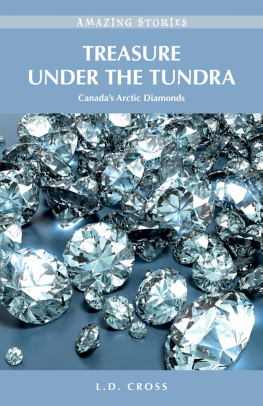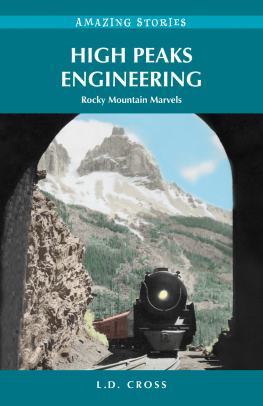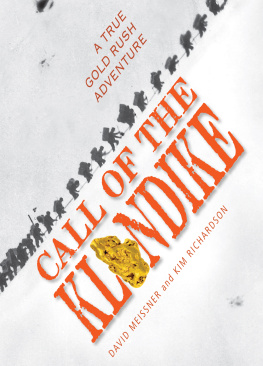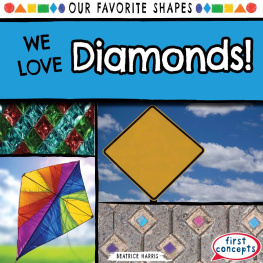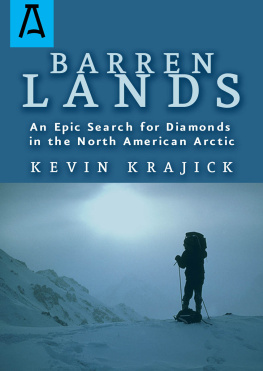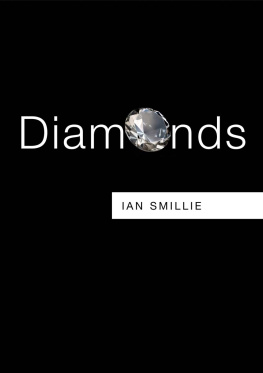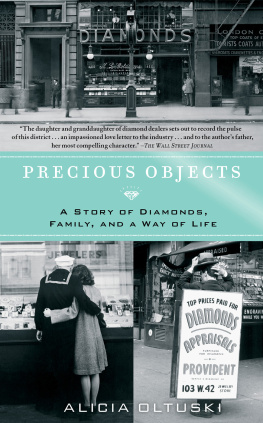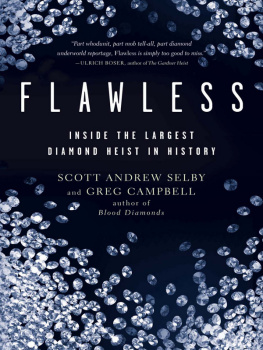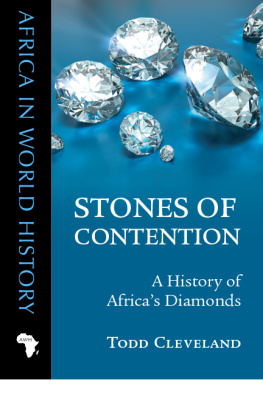Chapter
A Diamond is Forever
First came Jacques Cartier, who set sail from St. Malo, France, to find a passage around or through the New World to Cathay (China and India). If that was not possible, then he was to search for fabulous riches, like the gold the Spanish had found in South America. Cartier believed he had found diamonds and gold at the mouth of Rivire du Cap-Rouge during his third voyage to North America in 154142. On his return to France, the samples were discovered to be iron pyrites (fools gold) and worthless quartz crystals. This episode gave Quebecs Cap Diamant its name and was the basis for the saying faux comme des diamants du Canada (as false as diamonds from Canada). Then there was the fools gold brought back to England by Martin Frobisher in 1576 and his futile attempt to establish a mine for the Cathay Company on Baffin Island in 1578. Next came Samuel Hearne, who made three trips into the barren lands west of Hudson Bay tracking down rumours of vast mineral deposits. In 1771, he reached the Coppermine River, north of Great Slave Lake, and the shores of the Arctic Ocean but found only one piece of copper of any value.
The 1896 accidental discovery of placer gold on Rabbit (later Bonanza) Creek, a tributary of the Klondike River, by George Washington Carmack and his Native brothers-in-law Skookum Jim and Tagish Charlie, set off a gold and claim-staking rush in the Yukon. This find was the result of a tip by prospector Robert Henderson, who is now credited as co-discoverer. Today, the treasure is northern icenot the frozen but the carbon kind.
Diamonds are carbon that has been transformed under extreme heat and pressure into the hardest, clearest mineral on earth. The precise diamond-creating combination of pressure and temperature (4450 kilobars of pressure at a temperature of 1,000C) existed a few billion years ago, at depths of 125200 kilometres (80125 miles) under stable land. Some volcanoes that originate very deep within the earth force hot magma up to the surface through tubular pipes. This magma carried diamonds up close to the earths surface before solidifying into rock called kimberlite, a reference to the town of Kimberley in South Africa, where the discovery of an 83.5-carat (16.7-g) diamond in 1871 started a diamond rush. Only about 30 to 50 of the approximately 6,000 known kimberlite pipes in the world have ever become commercially viable mines. On the tundra, glacial ice covered the volcanic craters, but the movement of these glaciers eroded the kimberlite and carried the debris over the land, giving small clues to the treasure below. Lakes formed in the central depressions of the carrot-shaped kimberlite pipes, making geological exploration and diamond retrieval difficult for all but the most determined searchers.
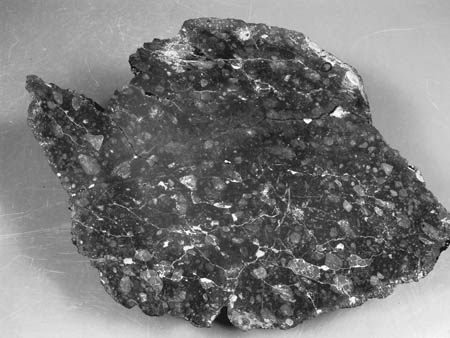
Kimberlite of Cretaceous age found at Lac de Gras, Northwest Territories.
Richard Herd. Natural Resources Canada, Earth Sciences Sector 2005-128
The word diamond comes from the Greek word adamas, meaning indestructible or unconquerable. Diamonds have long been sought after, fought over, prayed to and considered magical, powerful symbols. Their internal fire symbolizes the constant flame of love, and it was said that Cupids arrows were tipped with diamonds. They have been called shards of stars and tears of the gods. Diamonds can be mined in small-scale hand operations, by tunnelling through rock, placer-sifting through surface gravel, open-pit mining or mining the seabed. Diamonds were known before 3,000 bc, and until their discovery in Brazil in 1725, India was the main supplier.
The De Beers Group cartel (some call it a monopoly) mines 75 percent of the worlds diamonds. De Beers is based in Johannesburg, South Africa, and London, England, and has controlled most global diamond production and distribution since its founding in 1888 by Cecil Rhodes. In 1948, De Beers coined the advertising slogan a diamond is forever, but the catchy phrase was hardly new. The 1925 novel Gentlemen Prefer Blondes, by Anita Loos, contained the line: So I really think that American gentlemen are the best after all, because kissing your hand may make you feel very very good but a diamond and safire [sic] bracelet lasts forever.
Many stones obtained by anarchist groups and sold to finance wars, murders and terrorism have been contaminated by the label blood diamonds or conflict diamonds. The Kimberley Process Certification Scheme (KPCS) was established in 2003. It is an international agreement that imposes requirements to certify rough diamonds as conflict- free. Its aim is to prevent the trade in conflict diamonds while helping to protect the legitimate trade in rough diamonds. As of December 2009, the KPCS had 49 members in 75 countries (the European Union counted as one country). The KPCS is a joint government, industry and civil-society initiative. It is not an independent international body but involves a coalition of countries. Because many firms will not buy conflict diamonds directly from their country of origin, the diamonds are often smuggled into and sold through other countries. The KPCS has few tools to deal with corruption among diamond importers beyond asking governments to implement stricter industry regulations. The process relies on self-regulation by the member nations governments, making it difficult for the KPCS to enforce its own policies. A stronger, independent body composed of both exporters and importers is needed to regulate both sides of the diamond trade.
Loose diamonds can be purchased in their original rough state, but while finding such stones is a big thrill to diamond prospectors, consumers prefer cut and polished diamonds. It is the skill of the miner that brings the stones to the surface, but it is the craftsmanship of the cutter that brings light and life into the gems. Because of their rigid tetrahedral molecular structure (a triangular pyramid with four faces), a diamond can only be cut by another diamond or a laser. Cut diamonds are available in 11 shapes, but the most popular are round (brilliant), cushion, emerald and oval forms. The pear (teardrop) and marquise cuts are often seen in womens jewellery, like necklaces, as are princess and heart-shaped diamonds. The radiant, Asscher (stepped-square) and triangle (trilliant) cuts most often appear in mens jewellery, like cufflinks. Although clear diamonds are traditionally the most highly valued by consumers, diamonds come in different colours, and the more unusual colours can increase market value. Pink and blue diamonds are usually pale, but deep red, green or blue diamonds are prized and fetch high prices. Diamonds are now mined in about 27 countries and on every continent except Europe and Antarctica.
In 1980, there was no such thing as a Canadian diamondeverybody knew diamonds only came from Angola, Australia, Botswana, Congo (formerly Zaire), Namibia, Russia and, most important, South Africa. Today, Canada is the worlds third-largest producer (by value) of rough diamonds. Canadas reputation as an ethical producer of conflict-free diamonds has made its products economically attractive world wide, but this would never have happened had it not been for the determination and insight of two talented geologists. Prospectors Chuck Fipke and Stu Blusson believed that there were diamonds under the tundra and that they could find them. From 1980 to 1990, they scoured the mountains and the Barrens for samples that would show the indicator minerals often found in association with diamonds. They were adamant that they would find evidence of diamond-bearing kimberlites, those ancient pipes of volcanic rock that contain the prized crystals we call diamonds.
Next page
